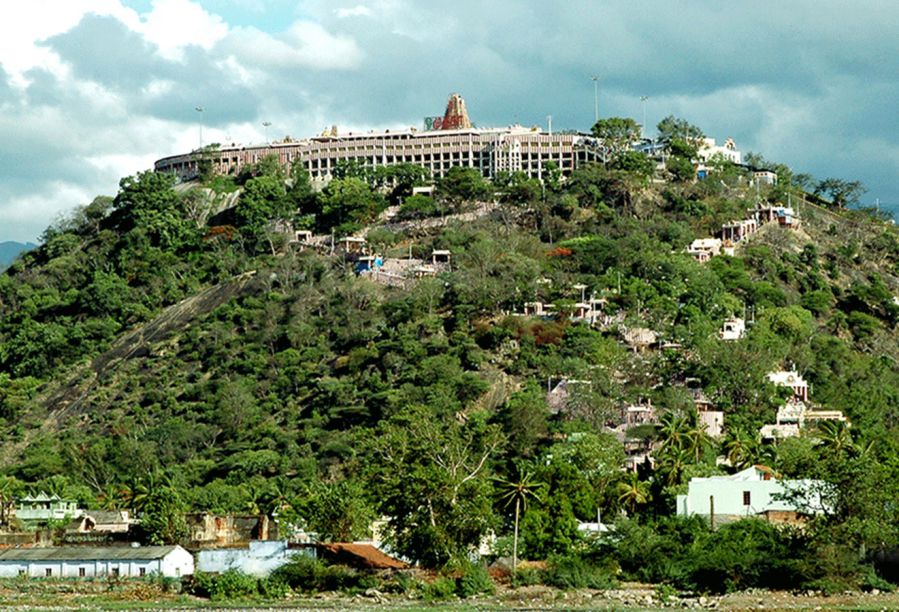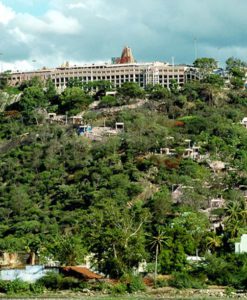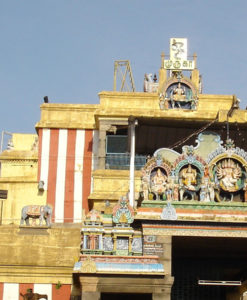No products in the cart.
Lord Murugan is the deity of the Tamil Land. Palani (Tiru Avinankudi) is the third Padai Veedu. The temple at Palani is an ancient one, situated at an elevation of 1500 feet above sea level. The deity of Palani is known as Dandayudhapani Swami, the Lord having the Staff in his Hand. The deity at the sanctum sanctorum is made out of an amalgam of nine minerals popularly called Navabashana. The deity is in a standing position with a baton in his hand. He has the look of a person who has renounced all worldly pomp. He has just a loincloth besides the baton. He is a mute messenger of the great precept ‘Renounce all to reach Me’. The icon is unique in the whole world. It was made by siddha Bhogar by combining nine poisonous substances (navabashana). Murugan signifies beauty and Lord Murugan of Kurinji land is the god of Beauty and Youth.
Palani Murugan Temple
There is a legend about how Lord Murugan came to this sacred spot. Narada Muni, a sage, brought a golden mango to the divine court of Lord Shiva when Lord Shiva was seated with his consort Parvati and His children, Lord Vinayakar and Lord Subramanya. Narada gave the fruit to Lord Shiva and implored Him to eat since it was a rare, miraculous Jñanaphalam, the fruit of wisdom. As a loving husband, Lord Shiva gave it to Parvati and requested her to eat. As a loving mother, she wanted to give the fruit to her children. As there was only one fruit and it should not be cut, they announced a contest and said that the winner would be given the fruit. Whoever completes one round of the globe first will be given the fruit.
Lord Subramanya mounted His peacock to go around the world. Lord Vinayakar circumambulated around His parents, symbolizing the world, and got the fruit. On return, Lord Subramanya found that He was cheated. In anger, He renounced His family and came to this spot to settle forever. Lord Shiva and Parvati came to pacify Him. They said, “Pazham Nee” (‘You are the Fruit’). Hence the name Palani is a popular syncopation of the two words mentioned.
The presiding deity, Lord Dandayudhapani Swami, is the son of Lord Shiva and son-in-law of Vishnu. He has other names such as Kulandaivelan, Balasubrahmanyan, Shanmukhan, Devasenapati, Swaminathan, Vallimanalan, Devayanaimanalan, Palaniandavar, Kuriñjiandavar, Arumugan, Jñana Pandita, Saravanan, Sevar Kodiyon, etc. Tamils, Keralites, Bengalis, Sri Lankans, Malaysians, Fijians, Africans, Australians and Americans to name a few come here to worship Lord Murugan. Thus Murugan worship cuts across provincial boundaries and national frontiers.
Cheaman Perumal, a ruler of Kerala, built the main temple perhaps in the 7th Century AD. The Nayaks built the Navaranga Mandapam which is a fascinating stone structure incorporated by four pillars and endowed with nine bays. The other portions of the temple have been built by the Pandiya kings, besides a number of local heads, religious groups and individual devotees.
There are six pujas every day. At 5 am the Lord gives Visvarupa Darshana. The first puja is Vizhapuja at 7:15 am followed by Kala sandhi at 8am, Uchikalam at 12 noon, Sayaraksha at 6 pm and Rakkalam at 8 pm.
The most esteemed form of worship at the temple is the abhishekam – anointment of the idol with oils, sandalwood paste, milk, unguents and the like and then bathing it with water in an act of ritual purification. The most prominent abhishekams are conducted at the ceremonies to mark the hours of the day. These are four in number – the Vizha Poojai, early in the morning, the Ucchikālam, in the afternoon, the Sāyarakshai, in the evening and the Rakkālam, at night, immediately prior to the temple being closed for the day. These hours are marked by the tolling of the heavy bell on the hill, to rouse the attention of all devotees to the worship of the lord being carried out at that hour. On a quiet day, the bell can be heard in all the countryside around Palani.

After the abhishekam, it is the practice to dress the idol of the Lord, in an act called alangaram, in one of several guises – the most common being the Raja, or king, the Vaitheekan, or priest, the Vedan, or hunter and the Aandi, or monk, which last is the most celebrated in Palani, because it is the nearest to the natural form the Lord assumed at Palani as an anchorite, having withdrawn from all the celestial riches of his father’s court at Mount Kailash. In addition to worship within the precincts of the temple, an idol of the Lord, called the Uthsavamoorthy, is also carried in state around the temple, in a golden chariot, drawn by devotees, most evenings in a year.
Over the years, some believe that the idol has been wearing away or dissolving, by virtue of its repeated anointment and ritual bathing. However, long-time devotees and priests of the temple maintain that they perceive no visible change. Since Hinduism forbids the worship of an imperfect idol, suggestions have been made, at various points of time, to replace it, cover it, or stop some of the rituals, which could have resulted in its erosion. A new 100 kg idol was consecrated on 27 January 2004, but coming under severe criticism from orthodox believers, was displaced and worship of the existing idol restored, shortly thereafter.







